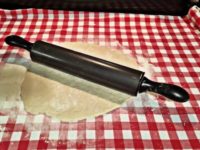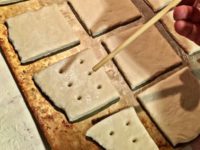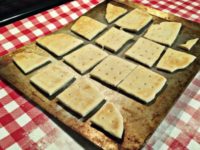Skilled Survival’s Step-by-Step Guide On How To A Make Hardtack
Maybe you’re trying to figure out what exactly hardtack is.
Or maybe you’re looking for the best step-by-step hardtack recipe?
You know, a hardtack biscuit recipe that will last many decades!
Either way, you’ve come to the right place.
Today, I will share everything I know about this amazing survival bread called hardtack. Including how to make hardtack at home:
-
What Is Hardtack – Brief History
-
Best Hardtack Recipe (ingredient list)
-
How To Make Hardtack At Home
-
Pemmican – Hardtack’s Meat Alternative
-
Bonus – ANZAC Biscuits Recipe
-
How To Make ANZAC Biscuits
Are You Ready For The Tough Times Ahead? Take My 60 Sec Quiz To See If You’re Part Of ‘The Fragile Masses’ Or Not… Start Quiz Now!
What Is Hardtack? – A Brief History
I’ve got to hand it to the ancient crews on old sailing ships and the medieval armies.
They prove “necessity is the mother of invention.”
History Eats: Hardtack – The staple of armies on the move for the last 1000 years.
For thousands of years, when currents and wind were a ship’s only means of propulsion, it took months to cross the high seas.
And yet, nearly every corner of the world was explored and mapped by the end of the “Golden Age of Sailing.”
These sailors endured long voyages that would regularly last months without a harbor.
Sometimes it was years before returning to their homeport.
These long trips required food stores that could last long periods at sea.
Voyaging long distances meant limited opportunities to resupply; remember, this is before refrigeration and canned food or canned bread!
So one of the staple foods on these ships was a simple, dense, hard survival bread called Hardtack. A survival biscuit made with three simple ingredients: flour, water, and salt.
Hardtack is a solid survival bread that holds up well to rough transport and is kept nearly indefinitely.
Since it was both inexpensive and nearly indestructible, this hard biscuit often made up most of a sailor’s rations.
In fact, in 1588, the British Royal Navy provided each sailor 1 lb. of hardtack biscuits and a gallon of beer PER DAY!
Obviously, this biscuit was a shipboard staple.
It became such a widespread staple different ports had unique names for hardtack, such as cabin bread, sea biscuits, survival bread, or ship biscuits.
Entire industries sprang up in ports to support the resupply of ships with more of this hardy stuff.
Now, if the flour, water, and salt sounds bland, you’re in good company. When a ship’s cook wasn’t within earshot, sailors often called it “dog biscuits,” “molar breakers,” or “sheet iron.”
Traditional hardtack is immensely HARD.
Why? Because you bake it, leave it out to dry, and store it with moisture-absorbing desiccants to prevent spoilage. Each step removes all moisture, making it difficult to bite and chew in its raw form.
Often you must soften it to make safe chewing possible.
However, there were many methods to soften the hard biscuits, including:
- soaking them in coffee
- drowning them in beer
- frying them with oil to make a hardtack pancake
- pounding them into crumbs with a rifle butt and stirring them into soup – (which both thickened the soup and softened the crumbs)
 Pretty resourceful, I’d say!
Pretty resourceful, I’d say!
While soaking them in coffee is still popular. Many people choose to eat them like toast by adding syrup or jam, providing a sweet (and calorie-dense) snack.
Of course, you can easily learn how to make hardtack at home for yourself with only three ingredients.
Many of the commercial recipes use additional ingredients. This is an attempt to improve the texture and taste, but these additions reduced the shelf life.
There are many recipe variations for homemade hardtack biscuits, bread, or crackers. But these homemade recipes are optimized for rapid consumption instead of prolonged storage.
Common commercial additions are sugar, honey, spices, powdered milk or eggs, and even oil and butter.
However, these hardtack recipes are best kept refrigerated since the additional ingredients compromise the shelf life. Especially oil and butter, which will go rancid quickly if left unrefrigerated.
If your ultimate goal is to store some survival calories for years to come, I recommend sticking to the three basic ingredients.
With such a long history and a fool-proof, inexpensive hardtack recipe, it’s no wonder it remains popular today. It’s become a food staple for homesteaders, survivalists, and preppers alike.
As A Way To Introduce You To Skilled Survival, We’re Giving Away Our Family First Food Planning Guide. Click Here To Get Your FREE Copy Of It.
Best Hardtack Recipe (ingredient list)
You can make hardtack with any flour you so choose.
- Whole wheat? Absolutely, it works great.
- Gluten-free? Yes, you can.
- Rye flour? A great alternative for those with wheat allergies.
With an afternoon of work (mostly baking), you can have ample hardtack that will last years.
How to Make Hardtack (Forever Lasting Bread)
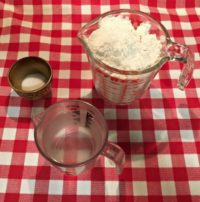
- 2.5 cups flour (+ a little extra)
- 1 cup of water
- 1 teaspoon salt
You’ll also need a few utensils:
- large mixing bowl
- rolling pin (or improvise!)
- cookie sheet
How To Make Hardtack Biscuits
Note: If you prefer to watch a video instead, skip to the end of this section.
Mixing The Ingredients
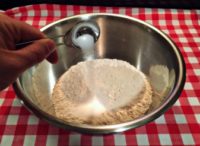
Pro tip: This is a great time to remove any rings on your fingers. Hardtack dough is very sticky, and you’ll have difficulty getting your rings clean later – trust me, I know!
After mixing your dry ingredients well, add the water in small amounts. You can mix and knead the dough by hand or with the bread hook attachment on a stand mixer.
Again, it’ll be extremely sticky but quickly become a uniform dough.
If it’s still sticky after several minutes of kneading, add a small amount of additional flour.
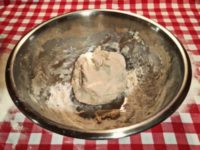
Rolling The Dough
Using a rolling pin, heavy pint glass, wine bottle, or even your hands, roll the dough out to roughly 1/4″-1/2” thick.
Cut the dough into serving-size portions.
This will be easier if you form the dough into a rough square (rather than a pizza crust circle).
If you’re not very experienced in using a rolling pin, you can use pencils as guides! Just lay a pencil on either side of the dough and press down until the rolling pin rests on the pencils.
Now, rolling back and forth will give you a nice flat piece of dough.
Cutting The Dough

Now using a knife or dough cutting blade cut it into manageable “cracker” size pieces. Ideally, you want them roughly the size of a saltine or graham cracker.
This cracker size is best for long-term storage and makes a good serving size for later.
I recommend a size that still fits in a mug if you plan to soak it with soup or coffee!
Poking The Crackers
Now, with your “sheet of crackers” cut to size, poke small holes spaced evenly across each piece.
These holes help the biscuit bake consistently. Ideally, you want both the edges and the middle of the hardtack biscuit to have a consistent bake.
The holes allow more moisture to escape and keep the dough from rising in the oven.
Also, the holes make it easier to break the tough biscuits into smaller chunks later for eating.
Baking The Crackers
Now, bake the dough for 25-35 minutes in a 375 deg oven until it just begins to brown on the surface.
You’re looking for a light tan, more than a brown. It’s very easy to scorch the flour, so pay close attention.
When you have a light tan color, take the survival biscuits out of the oven and allow them to cool COMPLETELY.
You want it to be 100% cool before putting it into any package to remove as much moisture from the biscuits as possible.
Any trace of excess moisture will cause your hardtack biscuits to spoil prematurely.
So if you live in a relatively dry climate, feel free to leave it out for several days to dry some more before storing it.
Storing Your Hardtack Biscuits
If it remains dry, you can store dry hardtack for months or even years.
Using a vacuum sealer, mylar bags, and desiccants will help remove moisture during storage, and a solid (metal) container keeps rodents out.
Keep the individual packages small, so you only open what you need while keeping the rest safe and dry.
Here’s an excellent video showing just how easy it is to make survival biscuits at home.
How to Make Hardtack (The Bread that Lasts Forever)
As you can see, making hardtack is about as easy as possible. You can even make a fun day out of it by including your kids or grandkids in the baking process.
And when you’re done, you’ll get the amazing feeling of comfort knowing you have nutritious bread to feed your family no matter the future.
As A Way To Introduce You To Skilled Survival, We’re Giving Away Our Family First Food Planning Guide. Click Here To Get Your FREE Copy Of It.
Pemmican – The Hardtack Meat Alternative
You cannot survive long-term on bread alone.
Your body needs other nutrients such as protein and vitamins as well. But when it comes to long-term food storage, not just any old protein will do.
Protein spoils rapidly without refrigeration.
That’s why you must learn how to make and store pemmican properly.
Pemmican is sort of like hardtack in protein form!
It’s a protein you can store for a lifetime without refrigeration.
Now, I’m not going to dive deep into the history and all the details of pemmican here because we’ve already written a detailed pemmican article.
But if you’re interested in seeing how pemmican is made, then check out the following short video.
How To Make Pemmican
Pemmican is another survival superfood that pairs up very well with hardtack for long-term storage and survival.
Bonus: Anzac Biscuits Recipe
While in survival mode, a coffee-soaked hardtack meal will fill an empty stomach, but no meal is complete without some dessert!
ANZAC is another “survival biscuit” with a long shelf-life. It was developed by the Australian and New Zealand Army Corps (ANZAC) families during World War 2.
The families back home wanted to send food and treats for the troops. But it had to survive months of travel from the South Pacific to Italy, where many of its soldiers were stationed.
This led to the creation of the “ANZAC Biscuit.”
Since then, it’s become a national staple in both countries, with recipes approved by the government to preserve the treat’s history.
Sure, ANZAC biscuits don’t have as long a shelf-life as hardtack (they contain both sugar and butter). However, ANZAC biscuits are a great short-term addition to any survival cache.
And they can be a welcome break from eating hardtack day in and day out!
ANZAC Biscuits Recipe
How To Make Anzac Biscuits
ANZAC Biscuit Ingredients:
- 1 cup each of rolled oats, sugar, and coconut
- 1 tablespoon golden corn syrup
- 3/4 cup flour
- 2 tablespoons butter
- 1 teaspoon baking soda (dissolved in 2 tablespoons boiling water)
ANZAC Biscuit Instructions
- Melt butter.
- Add corn syrup to dissolved soda and water. Combine with melted butter.
- Mix dry ingredients and stir in the liquid.
- Place small balls on a lightly greased cookie sheet and bake at 300deg for 20min or until golden brown.
Final Thoughts
So there you go.
Now you know how to make and store a life-saving survival bread as a simple biscuit – known as Hardtack.
Pair your hardtack with some pemmican, ANZAC biscuits, and bulk rice storage; you’ve got yourself a legitimate survival food stockpile.
You can have a ton of long-term calories on a prepper-friendly budget.
Now it’s just a matter of taking the knowledge and applying it. Because taking action now, long before you need it, is the real secret to survival.
Jason K.
P.s. Are you ready for the tough times ahead?
Find out now by taking my short Readiness Score Quiz – it’s absolutely free.
Once complete, you’ll know exactly where you stand on the “fragile” vs.” resilient” spectrum.
So click here to start the Quiz….And don’t worry; the questions are so easy a 3rd grader could answer them.
Click on the image to begin the Quiz and find out once and for all if you’re part of “The Fragile Masses” or “The Resilient Few.”
The post How to Make Hardtack: A Bread Recipe That Lasts A Lifetime appeared first on Skilled Survival.


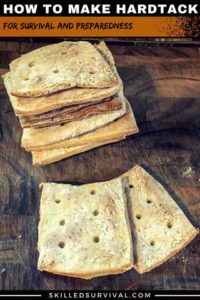
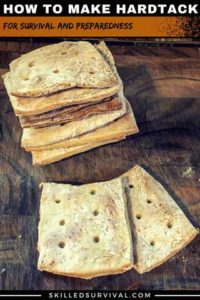


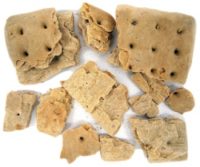 Pretty resourceful, I’d say!
Pretty resourceful, I’d say!